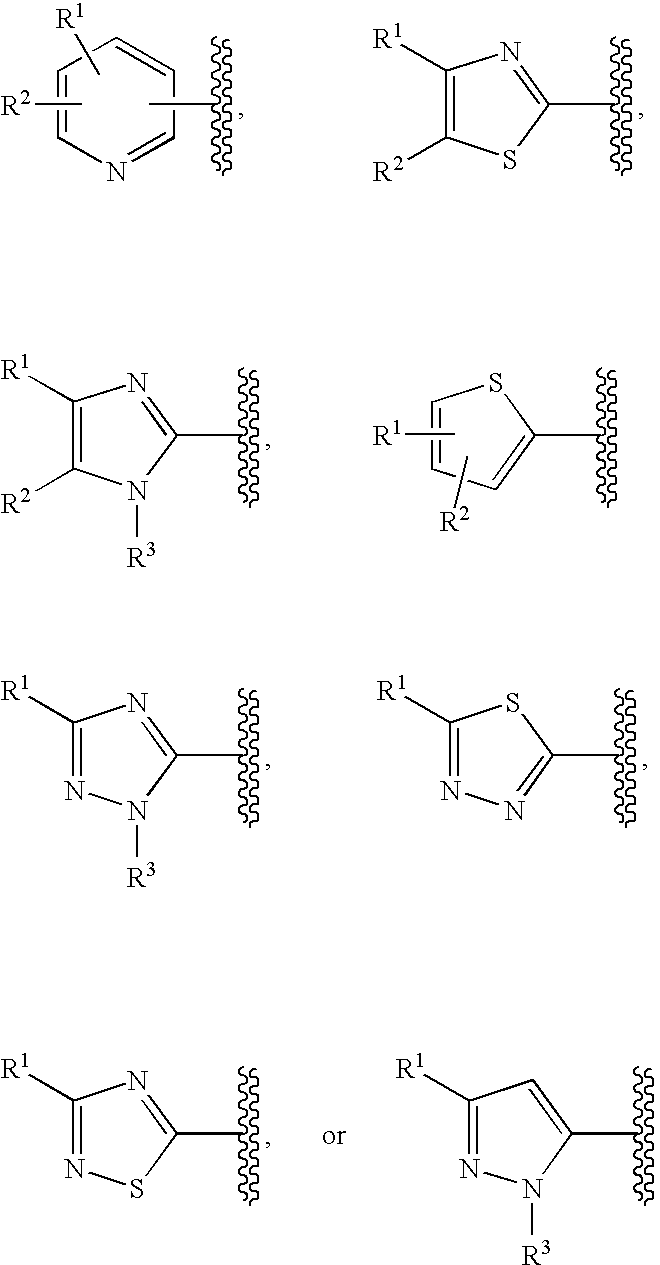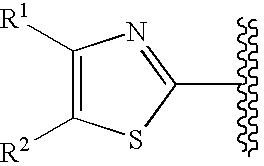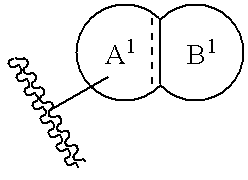Cyclic compounds exhibiting thrombopoietin receptor agonism
a technology of thrombopoietin and cyclic compounds, which is applied in the direction of drug compositions, extracellular fluid disorders, biocides, etc., can solve the problems that peptide derivatives are not generally practical for oral administration, and achieve the effect of increasing reducing the ratio of platelet number, and maintaining the number of platelets
- Summary
- Abstract
- Description
- Claims
- Application Information
AI Technical Summary
Benefits of technology
Problems solved by technology
Method used
Image
Examples
example
Example 1
Preparation of Compound (A-1)
[0189]
(Step 1)
[0190]To a solution of 3′,4′-dichloroacetophenone (1) (5.67 g) in 10% methanol-chloroform was added bromine (1.52 mL), and the reaction mixture was stirred at room temperature until a color of bromine was disappeared. The solvent was evaporated under reduced pressure and the residue was dissolved in ethanol again. To the reaction mixture was added thiourea (2.28 g) and the mixture was heated under reflux for 2 h. The solvent was evaporated under reduced pressure and to the residue were added ethyl acetate and water, and the resulting crystal was filtered. To the obtained crystal were added ethyl acetate and a saturated aqueous sodium bicarbonate solution, and the layer was separated. The organic layer was dried and evaporated under reduced pressure to give a compound (2) (3.38 g).
[0191]1H NMR (CDCl3, δ ppm): 7.89 (d, 1H, J=2.2 Hz), 7.69 (dd, 1H, J=8.5 Hz, 2. 2 Hz), 7.43 (d, 1H, J=8.2 Hz), 6.74 (s, 1H), 5.06 (bs, 2H).
(Step 2)
[0192]T...
example 2
[0207]By using a various aminothiazoles instead of a compound (2), compounds (B-1) to (B-32) were synthesized in a manner similar to Example 1. Their physical data were shown in Tables 5, 6, 7, 8, and 9.
[0208]
TABLE 5CompoundNo.R1R21H-NMR (DMSO d-6)B-1H12.70(bs, 2H), 8.37–8.42(m, 1H), 7.74–7.91(m, 4H), 7.52–7.57(m, 1H), 7.29(d,1H, J=7.7 Hz), 2.87–3.08(m, 4H), 2.69–2.77(m, 1H), 2.11–2.16(m, 1H), 1.79–1.99(m, 1H)B-2H12.57(bs, 1H), 7.83–7.90(m, 2H), 7.63–7.66(m, 2H), 7.56(s, 1H), 7.28(d, 1H,J=7.9 Hz), 7.11(d, 1H, J=7.9 Hz), 2.68–3.07(m, 9H), 2.10–2.16(m, 1H), 1.75–1.82(m, 5H)B-3H12.56(bs, 2H), 7.74–7.91(m, 4H), 7.65(s,1H), 7.34(t, 1H, J=7.6 Hz), 7.28(d, 1H, J=8.2 Hz), 7.15(d, 1H, J=7.3 Hz), 2.86–3.06(m, 4H), 2.61–2.77(m, 3H), 2.12–2.16(m, 1H), 1.73–1.86(m, 1H), 1.55–1.65(m, 2H), 1.29–1.40(m, 2H), 0.92(t,3H, J=7.3 Hz)B-4H12.73(bs, 1H), 12.40(bs, 1H), 8.34(t, 1H,J=8.2 Hz), 7.72–7.91(m, 5H), 7.29(d, 1H,J=7.3 Hz), 2.86–3.08(m, 4H), 2.69–2.77(m, 1H), 2.11(m, 1H), 1.73–1.86(m, 1H)B-5H12.66(bs...
example 3
Preparation of Compound (C-1)
(Step 1)
[0213]
[0214]Compound (2) (166 mg) synthesized by Example 1-Step 1, 2-ethoxycarbonyl-5-iodobenzothiophen (8) (150 mg), triethylamine (137 mg), and bis(triphenylphosphine)-palladium (II) dichloride (16 mg) were dissolved in DMF (3 mL), and the reaction mixture was heated with stirring at 90° C. for 1 h. To the reaction mixture was added a aqueous potassium hydrogen sulfate solution and the mixture was extracted with ethyl acetate. The organic layer was washed with brine, dried over magnesium sulfate, and evaporated under reduced pressure. The obtained residue was purified by silica gel column chromatography to give a compound (9) (247 mg).
[0215]1H NMR (CDCl3, δ ppm) 10.36 (bs, 1H), 8.41 (s, 1H), 8.09 (s, 1H), 7.95 (s, 2H), 7.84 (d, 1H, J=2.1 Hz), 7.58 (dd, 1H, J=8.5 Hz, 2.1 Hz), 7.34 (d, 1H, J=8.5 Hz), 7.22 (s, 1H), 4.45 (q, 2H, J=7.1 Hz), 1.45 (t, 3H, J=7.1 Hz).
(Step 2)
[0216]Compound (9) (217 mg) was dissolved in methanol (5 mL) and dioxane (3 mL)...
PUM
| Property | Measurement | Unit |
|---|---|---|
| affinity | aaaaa | aaaaa |
| weight | aaaaa | aaaaa |
| temperature | aaaaa | aaaaa |
Abstract
Description
Claims
Application Information
 Login to View More
Login to View More - R&D
- Intellectual Property
- Life Sciences
- Materials
- Tech Scout
- Unparalleled Data Quality
- Higher Quality Content
- 60% Fewer Hallucinations
Browse by: Latest US Patents, China's latest patents, Technical Efficacy Thesaurus, Application Domain, Technology Topic, Popular Technical Reports.
© 2025 PatSnap. All rights reserved.Legal|Privacy policy|Modern Slavery Act Transparency Statement|Sitemap|About US| Contact US: help@patsnap.com



